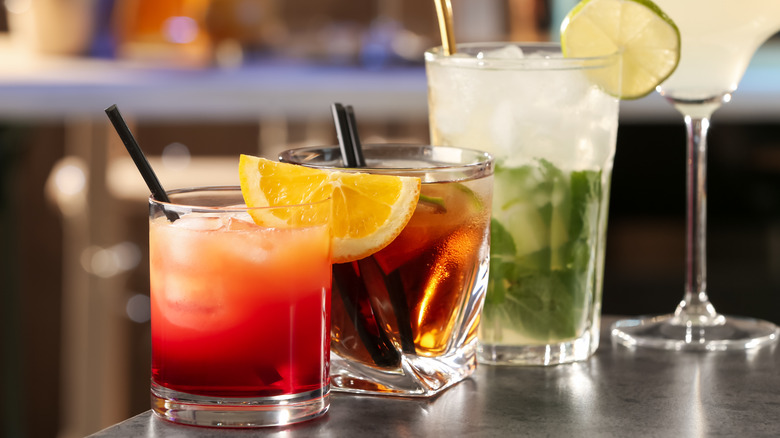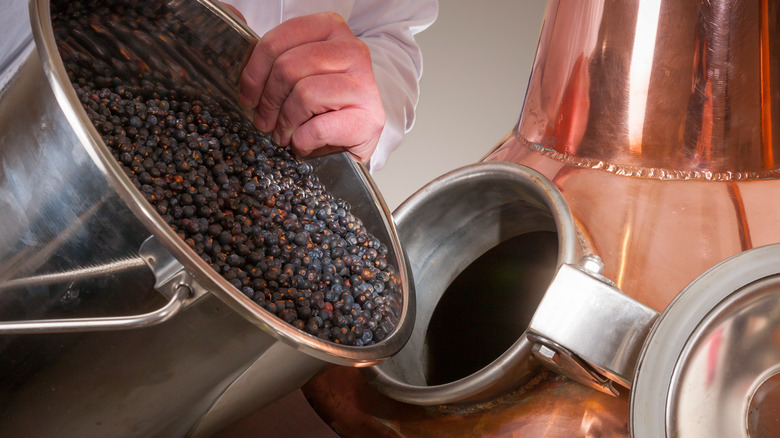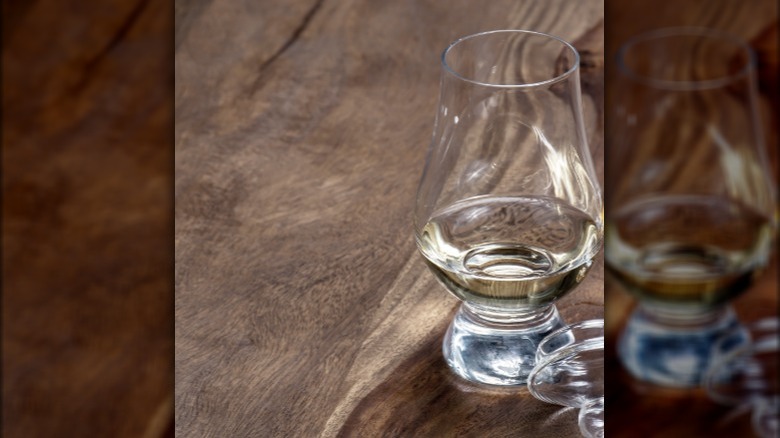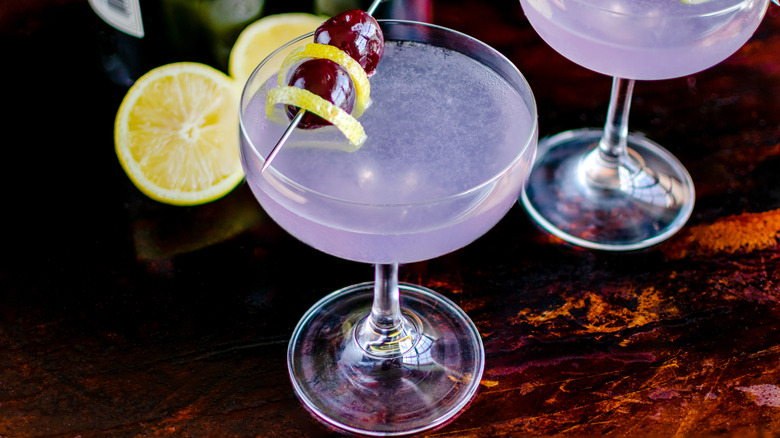What's The Best Type Of Glass For Gin?
Gin is a sophisticated spirit, so consuming gin ought to be a sophisticated experience, like witnessing a symphonic orchestra of botanicals and aromatics artistically attuned to a juniper melody. But what is an orchestra without a stage? As a classic symbol of sophistication, notes Gin Observer, the martini glass would be an obvious amphitheater to host the elegance of a masterfully distilled gin. However, as many servers and bartenders — and their patrons — know too well, the martini glass is not without its flaws.
Though sleek and chic, the V-shaped saucer is prone to spilling over, its mouth is substantially wider than the base (making it top-heavy), and its slender stem can be all too fragile. Ordering a martini "up" may mean spending more time safeguarding the glass than appreciating your cocktail, if there's even any left by the time you go to take a sip. It may be a time-honored symbol of refinement, but in practice, the martini glass is clumsy and ostentatious. But if the iconic martini glass isn't the best way to appreciate gin, what is?
That is a bit of a loaded question, given the vast diversity of gin and gin cocktails. To know what glass is best for gin, you should first get to know the kind of gin you're working with and the kind of cocktail it's intended for.
Gin genres
First off, gin doesn't have the same kind of strict restrictions that creatively limit other spirits like bourbon and scotch. In fact, according to the Code of Federal Regulations, the only real qualification is that the gin "must derive its main characteristic flavor from juniper berries and be bottled at not less than 40 percent alcohol by volume (80 proof)." This leaves distillers free to use all kinds of botanical infusions like coriander, citrus, and cardamom to enhance their product. Gins can be made anywhere in the world; they can be barrel-aged; they can be sweetened or spiced. With so much creative wiggle room, we tend to focus our understanding of gin genres primarily on the dynamic between juniper and botanicals or sweeteners.
According to Difford's Guide's detailed overview of gin styles, London dry is gin made without any artificial flavors or additional sweeteners, giving it a juniper-forward character with subtle notes of complimentary traditional botanicals — like Tanqueray, Beefeater, or Bombay. Old Tom gin refers to an older, Prohibition style of distilling that, at the time, required sweeteners and flavoring to make it more potable. Nowadays, an Old Tom label just means the gin has been artificially sweetened and made in a style reminiscent of the Prohibition era. Contemporary gin (or New Western dry gin) is the general term for dry gin that, while still featuring juniper, instead spotlights supporting or unconventional botanicals like blueberries, cucumber, and lavender.
A tulip snifter spotlights the gin itself
With all these varieties of gin, it may seem impossible to figure out the absolute best pairing of gin, cocktail, and glass, but the easiest way to get the best out of your gin is to know what you want from your drinking experience. Let's start simple: If you want to focus on the spirit on its own, to analytically discern the nuanced flavors of an artisanal gin, Stranger & Sons Gin partner Dimi Lezinska suggests to Architectural Digest that the best glass is a tulip snifter. The professional explains that "the balloon shape of the glass concentrates aromas at the bottom and directs those aromas softly to the nose."
A panel of "nosing experts" surveyed by Business Insider also highlighted that glasses with curved sides not only provide the ideal vessel for the aroma's journey to your nose but also allow you to swirl the spirit, thereby accessing more subtle levels of taste and smell. If you're trying out some new botanicals, for example, this is the best way to appreciate them.
Outside a targeted gin tasting, though, the problem is that there are simply too many different kinds of gin cocktails (not to mention gins themselves) for there to be a one-glass-fits-all solution. Because of the spirit's distinct and dynamic character, gin cocktails can range from brooding and boozy, like a Negroni, to light and delicate, like a bee's knees, to thirst-quenching, like a Tom Collins ... all of which call for a variety of glasses to enhance the overall cocktail.
The perfect glass for your cocktail
If you want something refreshingly crisp and effervescent, go with a classic London dry gin and tonic over ice in a highball glass. Using a London dry gin lets juniper take center stage, bolstered by the tonic, while the highball glass provides space for ice and a narrow mouth to retain carbonation.
However, if you want to prioritize ice retention, the folks at Gin Observer recommend a Copa (or balloon) glass. This is a high-volume vessel similar to a wine glass, but the mouth curves back in like a fish bowl. This shape allows the gin to breathe while still trapping the aromas. More importantly, the glass can accommodate an exceptional amount of ice, and holding it by its stem reduces the transferred body heat.
What if, instead, you wanted something refined and sophisticated like a martini or gimlet — surely then a martini glass would be appropriate? According to Architectural Digest, though the coupe and martini glass offer essentially the same utility and aesthetic function, the rounded bowl of the coupe glass is less prone to spilling and is generally smaller and safer than its martini counterpart. Hence, craft mixologists are beginning to adopt the coupe glass for a variety of elegant gin cocktails, from martini to aviation.
Ultimately, the best glass for gin comes down to what gin you're using and how and why you want to use it. Whatever the situation, consider how you intend your gin and glass to interact, and weigh your priorities: aesthetics versus aromatics, carbonation versus surface area, or juniper versus botanicals.



